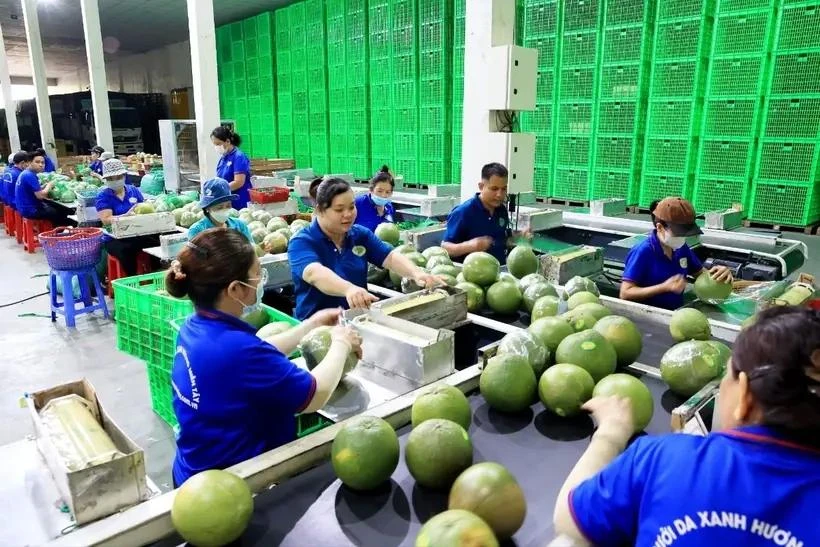 |
| A green-skin pomelo packaging line for export in Mo Cay Bac district, Ben Tre province. (Photo: VNA) |
The country earned 3.83 billion USD from exporting fruit and vegetables in the first seven months of 2024, up 24.3% compared to the same period last year. Notably, this sector has seen double-digit growth in the top 10 export markets (excluding the Netherlands).
Recently, the Republic of Korea (RoK) agreed to import fresh pomelo from Vietnam.
According to General Secretary of the Vietnam Fruit and Vegetables Association Dang Phuc Nguyen, the export value of Vietnamese fruit and vegetables to the RoK and Japan is on the rise. In addition to building a brand and position in the traditional Chinese market, the fruit and vegetable sector is increasingly expanding in the Northeast Asian region.
China was the biggest importer of Vietnamese fruit and vegetables in Northeast Asia, accounting for 64% of the total export turnover, up 22% compared to the same period last year. It was followed by the RoK, up 55% year-on-year.
In the future, Northeast Asia will be a strategic market for Vietnamese fruits and vegetables, Nguyen said, adding that export companies will not only benefit from tariff advantages but also reduce transportation and logistics costs compared to other markets such as the EU and the US.
According to the Plant Protection Department (PPD) under the Ministry of Agriculture and Rural Development (MARD), within the Regional Comprehensive Economic Partnership (RCEP) Agreement, Vietnam is allowed to export the largest number of fruit products to China, with 12 official products. China has also approved the temporary and pilot import of Vietnamese passion fruits and coconuts, respectively.
The PPD is working on opening the market for citrus fruits, medicinal plants, and frozen durian to China. Additionally, Vietnam is also negotiating for exporting passion fruit, longan, and lychee to Australia; and passion fruit and grapefruit to New Zealand.
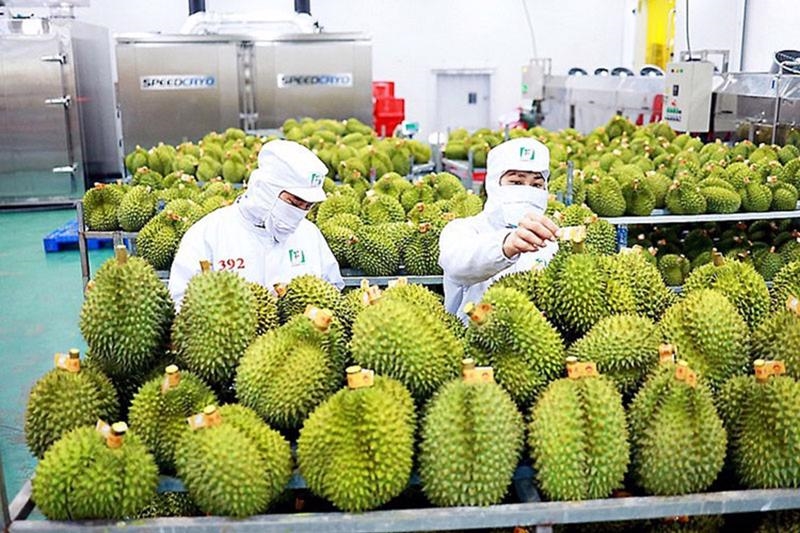 |
| Durian is the leading fruit in export in the fruit and vegetable industry of Vietnam. (Photo: vneconomy.vn) |
Vietnamese producers and exporting companies must pay attention to continuously updating import regulations in various markets to ensure timely compliance, Nguyen said.
According to Deputy Director of the PPD Nguyen Quang Hieu, the area of durian with newly-granted farming area codes is about 25,000 ha among 150,000 ha nationwide. Vietnam is focusing on not only expanding cultivation areas with farming area codes, but also controlling and managing the quality of products.
A protocol on the official export of frozen durian to China is being promoted, and is expected to be signed in 2024, he said.
Deputy Minister of Agriculture and Rural Development Phung Duc Tien said sensitivity and strict adherence to international regulations are fundamental solutions for the sustainable development of all sectors, including fruits and vegetables.
The MARD, along with other ministries, agencies, and local authorities, are tightening quality management and monitoring of cultivation areas, he stressed, adding that effective solutions to quality issues are needed to achieve higher growth in fruit and vegetable exports.
Ca Mau rice-shrimp cultivation model receives first BAP certification
The rice-shrimp cultivation area of Thoi Binh district in the Mekong Delta province of Ca Mau has received Best Aquaculture Practices' (BAP) certification of the Global Aquaculture Alliance (GAA), reported Vietnam News Agency.
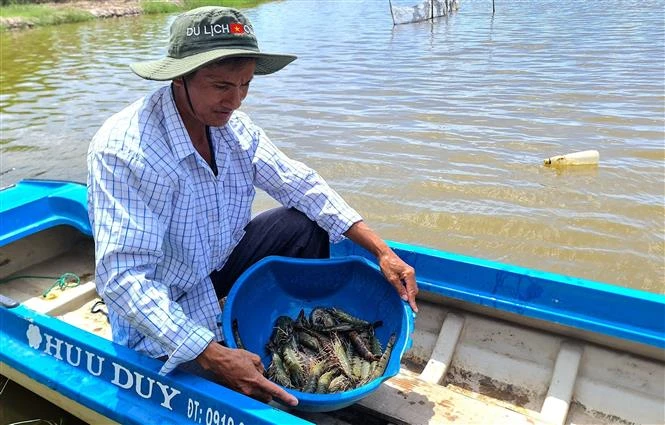 |
| Rice-shrimp cultivation has proved its efficiency in climate change adaption and income improvement (Photo: VNA) |
The certification is the first presented to an aquatic farming establishment in Vietnam.
Vo Van Duoc, a local farmer engaging in BAP project for two years, said that the model has helped his family earn 80 million VND (3,198 USD) per hectare each year.
Vice Chairman of the People’s Committee of Bien Bach Dong commune Nguyen Phi Thoang said that after more than two years of implementation, the project in the locality has proved its efficiency in climate change adaption and income improvement.
Currently, the model has drawn 321 households in the commune with a total farming area of more than 696 hectares. In the coming time, it plans to expand the area to about 2,000 hectares, Hoang said.
Meanwhile, Vice Chairman of the People’s Committee of Thoi Binh district Nguyen Hoang Boa said that Thoi Binh boasts high potential for shrimp-rice cultivation models. The BAP will help the locality ensure sustainable farming for small-scale facilities, thus minimising negative impacts on the environment, ensuring social benefits, and contributing to changing production habits and mindset of farmers and businesses, he said.
A representative from the German Agency for International Cooperation (GIZ) said that there are currently many standards that have been applied in aquaculture in Vietnam such as SQF, GlobalGAP, ASC, BAP, Naturland, AquaGAP, and VietGAP. However, the important standards that are commonly applied for shrimp export today are ASC, GlobalGAP and BAP.
The common point of these three standards is to focus on ensuring food hygiene and safety, disease safety, environmental safety, social safety, and product traceability.
Therefore, by achieving BAP certification, Ca Mau shrimp in particular and Vietnamese shrimp in general will enjoy a wider door to most demanding countries in the world, the representative said, explaining that GAA currently has more than 1,100 members in 70 countries and has become the most prominent organisation representing the global seafood industry.
A representative from Minh Phu company, which engages in the project’s implementation, said that thanks to the BAP certification, products by households in the chain will be purchased by the associated enterprise for all BAP-certified shrimp at a price higher than the market price.
This is a good condition and opportunity for Ca Mau to promote the image of local shrimp to the world market, especially in demanding markets with strict standards, the representative said.
Female Vietnamese referees to officiate at 2024 Women's U17 World Cup
FIFA has appointed two female Vietnamese referees Le Thi Ly and Ha Thi Phuong to officiate games at the 2024 U17 Women’s World Cup, due to take place in the Dominican Republic from October 16 to November 3, reported the Voice of Vietnam.
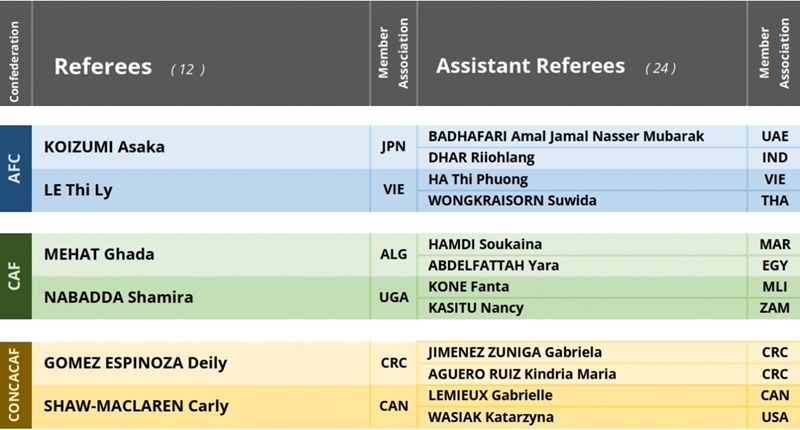 |
| Le Thi Ly and Ha Thi Phuong will officiate at 2024 Women's U17 World Cup (Photo: FIFA) |
The two Vietnamese referees are among a total of 38 officials who will be officiating the competition.
Le Thi Ly from Ho Chi Minh City will work as a main referee during the finals of the tournament.
She is one of three female Vietnamese referees accredited by FIFA and is a senior referee of the Asian Football Confederation (AFC).
Ly also officiated the match between the women's national football teams of the Democratic People’s Republic of Korea (DPRK) and Japan held on February 24 in Pyongyang.
Last year she was assigned to take charge of games in the qualifiers for the AFC U20 Women’s Asian Cup, the 19th Asian Games (ASIAD 19), the 2024 Paris Olympics’ second qualifiers, and the AFC Women's Club Championship.
Meanwhile, Ha Thi Phuong from northern Hai Phong city will serve as an assistant referee at the tournament.
She has also worked for the AFC at several tournaments such as the AFC Women's Clubs Championship 2023 and 2024 Olympic qualifiers.
This year the Vietnamese U17 women’s team will not participate in the tournament as they failed to make it through the qualifying round.
Hanoi gains impetus for urban railway development
The first two first urban railway lines in Hanoi have attracted a large number of passengers, helping modernise the public transportation network and ease traffic congestion, which is an important prerequisite for the city to strongly develop this means of transport in the coming time, reported Vietnam News Agency.
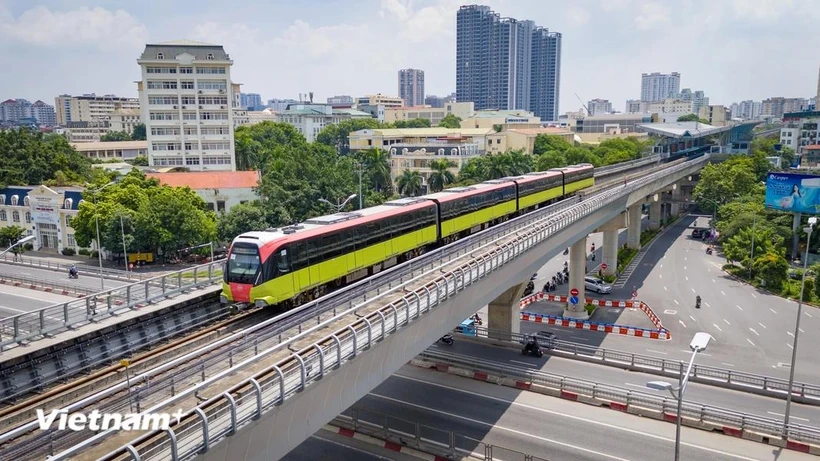 |
| The elevated section of the Nhon - Hanoi Station railway line was officially put into use on August 8. (Photo: VNA) |
The elevated section of the second urban railway line, Nhon - Hanoi Station, was officially put into use on August 8. It served more than 306,000 passengers on the first five days.
Meanwhile, the first line, Cat Linh - Ha Dong, transports about 10 million passengers each year.
These results are believed to be an important impetus for Hanoi to strongly develop its urban railway system in the time ahead.
The municipal People’s Committee recently submitted a draft master plan on building urban railway to the municipal People’s Council for discussion.
This plan proposes urban railway development be divided into three phases.
From 2024 to 2030, the city will complete constructing 96.8km of railway and make investment preparations for another 301km. More than 14.6 billion USD is needed for this period.
And between 2031 and 2035, 301km of railway will be built at a total cost of over 22.57 billion USD. The local urban railway system is expected to serve 35 - 40% of public transport passengers after 2030.
Meanwhile, Hanoi plans to complete an additional 200.7km during 2036 – 2045, which requires funding of over 18.25 billion USD.
The local administration estimates that by 2035, the city will able to mobilise about 28.56 billion USD from different sources for the work and need around 8.61 billion USD in assistance from the central budget for the 2026 - 2030 and 2031 - 2035 periods.
Vice Chairman of the municipal People’s Committee Ha Minh Hai said one of the most important factors of urban railway development is finance, and the biggest financial resource is the added value from the land traversed by urban railway lines, which could be optimised through transit-oriented development (TOD).
TOD is an urban development model with rapid public transport being the centre that is closely connected with the formation and expansion of the urban railway network.
Le Trung Hieu, Deputy Director of the municipal Department of Planning and Investment, said that with the recent adoption of the revised Law on the Capital, the National Assembly and the Government have given Hanoi a “golden key” to address decades-long difficulties and obstacles hampering the development of transport infrastructure, especially urban railway.
The revised law is one of the critical policy frameworks for developing urban railway and the TOD as Hanoi is granted the right to make decisions about urban railway projects by itself, he noted./.